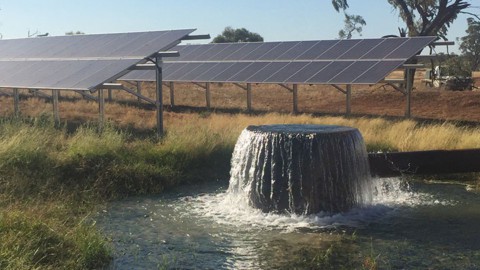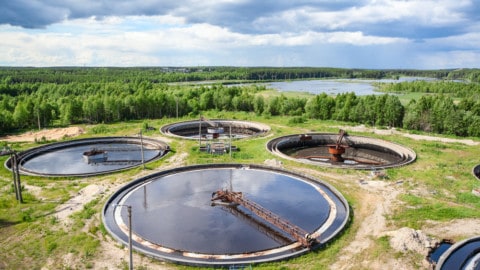Gorman-Rupp and leading designer Yves Givron have developed the fourth generation wet well self-cleaning sump (SCS) to keep the fluid in the system moving and maximising self cleaning to improve many of the issues faced by pump stations.
Designed for use with self-priming Gorman-Rupp pumps, the SCS system aims to:
- Eliminate blockages caused by the build-up of rags and stringy materials
 Eliminate sediment buildup in the sump
Eliminate sediment buildup in the sump
- Eliminate fat and grease buildup
- Eliminate air entrainment
- Reduce energy consumption
- Reduce gases and odours
- Eliminate the need for well washing
- Greatly reduce blockages in the pump
- Greatly reduce maintenance costs
- Reduce civil costs
The design concept
The premise is simple: keep the liquid moving for as long as possible; do the majority of the pumping at a liquid level that produces the best cleaning effect; keep non-pumping times short; and use equipment that is reliable, safe, easy to access, and easy to maintain.
 The complete system consists of:
The complete system consists of:
- A Gorman-Rupp self priming packaged pump station with VFD controls
- A short sloping collector pipe in HDPE which replaces the conventional concrete wet well
- A modified maintenance/manhole with sloping bottom to direct flow into the SCS
An operating procedure designed to clean solids out with every cycle
The mode of operation is an important component in the design philosophy.
The pump starts at the ‘on level’ at full speed to maximise re-priming lift and minimising re-prime time. It slows down at the ‘regulation level’.
At this level, the velocity is at its highest to transport solid matter, including silt, fats and grease and stringy material. The VFD controls maintain this level by speeding the pump up or slowing it down for between three and five minutes.
If the pre-set minimum speed is able to lower the level, or if the pre-set regulation level time limit has been reached, the pump will speed back up to maximum speed, pumping down to the ‘off level’ to empty the SCS.
The faster speed is designed for maximum self cleaning to remove as much silt, fat and stringy materials as possible.
If there is a longer than acceptable delay between the next pumping cycle, the pump will cut in prior reaching the normal ‘on level’ so that solids do not get a chance to settle.
This mode of operation is designed to keep solids moving and minimise the chance of silt buildup or stringy materials balling or matting together.
This should minimise blockages and reduce solids buildup, eliminating the need for expensive operations like sucker truck call outs. Also, because the suction line entry for the pump is at the farthest point from the influent line, the chances of air entrainment is close to zero.
Fat buildup is also eliminated because the system keeps the fat, grease and floatables moving so that they cannot build up. This eliminates the need for well washing equipment, and reduces the odours and gases created by these stagnating solids.
The mode of operation also reduces energy consumption. Because the longest part of the pump cycle is at the ‘regulation level’, and the flow rate and head is lower than it is at the design flow, the power consumption is at its lowest during the longest part of the cycle. This reduces the overall energy use at the pump station.
The SCS keeps the flow moving, reducing maintenance associated with the wet well, but the “problems” sent to the pump are also reduced. Because solids are not given a chance to ball together, the solids going to the pump are smaller.
This does not mean that the pump should not be the best solids handling pumps available.
 All self-cleaning sumps (SCS) need to be paired with above ground self-priming pumps. Gorman-Rupp’s Ultra V Series or Super T Series sewage pumps are most suitable.
All self-cleaning sumps (SCS) need to be paired with above ground self-priming pumps. Gorman-Rupp’s Ultra V Series or Super T Series sewage pumps are most suitable.
Gorman-Rupp has been at the cutting edge of this technology for over 50 years and offers the most advanced pumping equipment for reliability, maintenance, non-clogging and un-clogging.
Self-priming pump stations are easy to access, making access to valves, gauges, motors and the pumps much easier than having to open wet well and valve vault lids.
Gorman-Rupp sewage pumps, available from Hydro Innovations, can be fitted with the new Eradicator™ solids management system to handle the toughest ragging applications.
The Eradicator™ system features an aggressive self-cleaning wear plate incorporating a number of notches and grooves, as well as a patent-pending lacerating tooth that helps break up stringy materials and pass them through the pump without impacting performance or interrupting service.
The Eradicator™ system also comes with a smaller and lighter inspection cover plate to make it easier for operators to inspect pump internals and remove blockages if a blanket or similar item works its way into the system.
This is vastly simpler and much safer and more cost effective than opening wet well lids, hooking up cranes to submersible pump chains, and hauling them out.
The SCS concept in conjunction with a Gorman-Rupp packaged pump station can improve many of the issues confronting sewage pump station designers and asset owners. This new approach can reduce blockages, odours, air entrainment, energy costs, maintenance costs and construction costs. It can also greatly improve operator safety.
This partner content is brought to you by Hydro Innovations. For more information, visit http://www.hydroinnovations.com.au/pump-applications/self-cleaning-sump/.


















